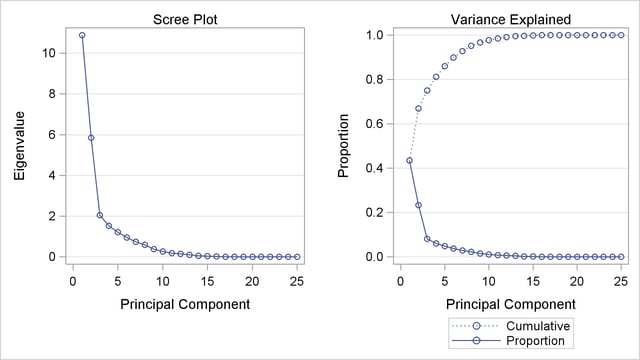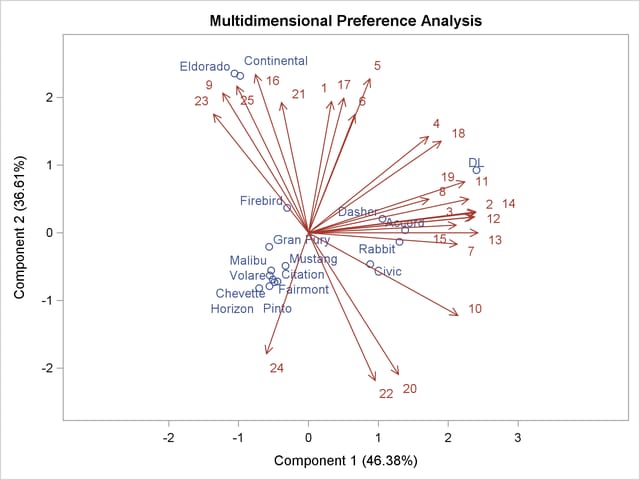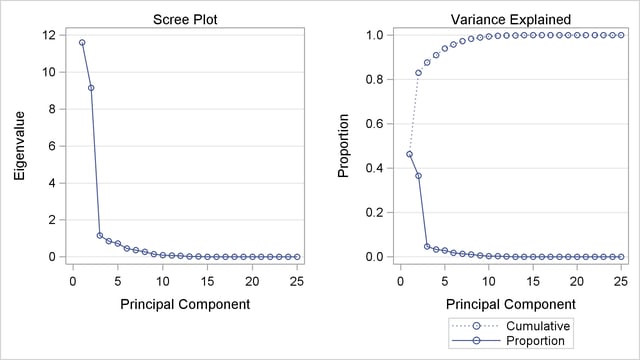| The PRINQUAL Procedure |
Example 71.1 Multidimensional Preference Analysis of Automobile Data
This example uses PROC PRINQUAL to perform a nonmetric multidimensional preference (MDPREF) analysis (Carroll; 1972). MDPREF analysis is a principal component analysis of a data matrix with columns that correspond to people and rows that correspond to objects. The data are ratings or rankings of each person’s preference for each object. The data are the transpose of the usual multivariate data matrix. (In other words, the columns are people; in the more typical matrix the rows represent people.) The final result of an MDPREF analysis is a biplot (Gabriel; 1981) of the resulting preference space. A biplot displays the judges and objects in a single plot by projecting them onto the plane in the transformed variable space that accounts for the most variance.
In 1980, 25 judges gave their preferences for each of 17 new automobiles. The ratings were made on a 0 to 9 scale, with 0 meaning very weak preference and 9 meaning very strong preference for the automobile. The following statements create a SAS data set with the manufacturer and model of each automobile along with the ratings:
title 'Preference Ratings for Automobiles Manufactured in 1980';
options validvarname=any;
data CarPref;
input Make $ 1-10 Model $ 12-22 @25 ('1'n-'25'n) (1.);
datalines;
Cadillac Eldorado 8007990491240508971093809
Chevrolet Chevette 0051200423451043003515698
Chevrolet Citation 4053305814161643544747795
Chevrolet Malibu 6027400723121345545668658
Ford Fairmont 2024006715021443530648655
Ford Mustang 5007197705021101850657555
Ford Pinto 0021000303030201500514078
Honda Accord 5956897609699952998975078
Honda Civic 4836709507488852567765075
Lincoln Continental 7008990592230409962091909
Plymouth Gran Fury 7006000434101107333458708
Plymouth Horizon 3005005635461302444675655
Plymouth Volare 4005003614021602754476555
Pontiac Firebird 0107895613201206958265907
Volkswagen Dasher 4858696508877795377895000
Volkswagen Rabbit 4858509709695795487885000
Volvo DL 9989998909999987989919000
;
The following statements run PROC PRINCOMP and create a scree plot. The results of this step are shown in Output 71.1.1.
ods graphics on; * Principal Component Analysis of the Original Data; proc princomp data=CarPref; ods select EigenvaluePlot; var '1'n-'25'n; run;

The scree or eigenvalue plot in Output 71.1.1 shows that two principal components should be retained. There is a clear separation between the first two components and the remaining components. There are eight eigenvalues that are precisely zero because there are eight fewer observations than variables in the data matrix. One additional eigenvalue is zero, for a total of nine zero eigenvalues, since the correlation matrix is based on centered data. The following statements create the data set and perform a principal component analysis of the original data.
PROC PRINQUAL fits the nonmetric MDPREF model. PROC PRINQUAL monotonically transforms the raw judgments to maximize the proportion of variance accounted for by the first two principal components. The MONOTONE option is specified in the TRANSFORM statement to request a nonmetric MDPREF analysis; alternatively, you can instead specify the IDENTITY option for a metric analysis. Several options are used in the PROC PRINQUAL statement. The option DATA=CarPref specifies the input data set, OUT=Results creates an output data set, and N=2 and the default METHOD=MTV transform the data to better fit a two-component model. The REPLACE option replaces the original data with the monotonically transformed data in the OUT= data set. The MDPREF option standardizes the component scores to variance one so that the geometry of the biplot is correct, and it creates two variables in the OUT= data set named Prin1 and Prin2. These variables contain the standardized principal component scores and structure matrix, which are used to make the biplot. If the variables in data matrix  are standardized to mean zero and variance one, and
are standardized to mean zero and variance one, and  is the number of rows in
is the number of rows in  , then
, then  is the principal component model, where
is the principal component model, where  . The
. The  and
and  contain the eigenvectors and eigenvalues of the correlation matrix of
contain the eigenvectors and eigenvalues of the correlation matrix of  . The first two columns of
. The first two columns of  , the standardized component scores, and
, the standardized component scores, and  , which is the structure matrix, are output. The advantage of creating a biplot based on principal components is that coordinates do not depend on the sample size. The following statements transform the data and produce Output 71.1.2.
, which is the structure matrix, are output. The advantage of creating a biplot based on principal components is that coordinates do not depend on the sample size. The following statements transform the data and produce Output 71.1.2.
* Transform the Data to Better Fit a Two Component Model;
proc prinqual data=CarPref out=Results n=2 replace mdpref;
title2 'Multidimensional Preference (MDPREF) Analysis';
title3 'Optimal Monotonic Transformation of Preference Data';
id model;
transform monotone('1'n-'25'n);
run;
| Preference Ratings for Automobiles Manufactured in 1980 |
| Multidimensional Preference (MDPREF) Analysis |
| Optimal Monotonic Transformation of Preference Data |
| PRINQUAL MTV Algorithm Iteration History | |||||
|---|---|---|---|---|---|
| Iteration Number |
Average Change |
Maximum Change |
Proportion of Variance |
Criterion Change |
Note |
| 1 | 0.24994 | 1.28017 | 0.66946 | ||
| 2 | 0.07223 | 0.36958 | 0.80194 | 0.13249 | |
| 3 | 0.04522 | 0.29026 | 0.81598 | 0.01404 | |
| 4 | 0.03096 | 0.25213 | 0.82178 | 0.00580 | |
| 5 | 0.02182 | 0.23045 | 0.82493 | 0.00315 | |
| 6 | 0.01602 | 0.19017 | 0.82680 | 0.00187 | |
| 7 | 0.01219 | 0.14748 | 0.82793 | 0.00113 | |
| 8 | 0.00953 | 0.11031 | 0.82861 | 0.00068 | |
| 9 | 0.00737 | 0.06461 | 0.82904 | 0.00043 | |
| 10 | 0.00556 | 0.04469 | 0.82930 | 0.00026 | |
| 11 | 0.00445 | 0.04087 | 0.82944 | 0.00014 | |
| 12 | 0.00381 | 0.03706 | 0.82955 | 0.00011 | |
| 13 | 0.00319 | 0.03348 | 0.82965 | 0.00009 | |
| 14 | 0.00255 | 0.02999 | 0.82971 | 0.00006 | |
| 15 | 0.00213 | 0.02824 | 0.82976 | 0.00005 | |
| 16 | 0.00183 | 0.02646 | 0.82980 | 0.00004 | |
| 17 | 0.00159 | 0.02472 | 0.82983 | 0.00003 | |
| 18 | 0.00139 | 0.02305 | 0.82985 | 0.00003 | |
| 19 | 0.00123 | 0.02145 | 0.82988 | 0.00002 | |
| 20 | 0.00109 | 0.01993 | 0.82989 | 0.00002 | |
| 21 | 0.00096 | 0.01850 | 0.82991 | 0.00001 | |
| 22 | 0.00086 | 0.01715 | 0.82992 | 0.00001 | |
| 23 | 0.00076 | 0.01588 | 0.82993 | 0.00001 | |
| 24 | 0.00067 | 0.01440 | 0.82994 | 0.00001 | |
| 25 | 0.00059 | 0.00871 | 0.82994 | 0.00001 | |
| 26 | 0.00050 | 0.00720 | 0.82995 | 0.00000 | |
| 27 | 0.00043 | 0.00642 | 0.82995 | 0.00000 | |
| 28 | 0.00037 | 0.00573 | 0.82995 | 0.00000 | |
| 29 | 0.00031 | 0.00510 | 0.82995 | 0.00000 | |
| 30 | 0.00027 | 0.00454 | 0.82995 | 0.00000 | Not Converged |
The iteration history displayed by PROC PRINQUAL indicates that the proportion of variance is increased from an initial 0.66946 to 0.82995. The proportion of variance accounted for by PROC PRINQUAL on the first iteration equals the cumulative proportion of variance shown by PROC PRINCOMP for the first two principal components. PROC PRINQUAL’s initial iteration performs a standard principal component analysis of the raw data. The columns labeled Average Change, Maximum Change, and Criterion Change contain values that always decrease, indicating that PROC PRINQUAL is improving the transformations at a monotonically decreasing rate over the iterations. This does not always happen, and when it does not, it suggests that the analysis might be converging to a degenerate solution. See Example 71.2 for a discussion of a degenerate solution. The algorithm does not converge in 30 iterations. However, the criterion change is small, indicating that more iterations are unlikely to have much effect on the results.
The biplot, shown in Output 71.1.3, is automatically displayed by PROC PRINQUAL when ODS Graphics is enabled and the MDPREF option is specified.

The second PROC PRINCOMP analysis is performed on the transformed data. The WHERE statement is used to retain only the monotonically transformed judgments. The scree plot shows that the first two eigenvalues are now much larger than the remaining smaller eigenvalues. The second eigenvalue has increased markedly at the expense of the next several eigenvalues. Two principal components seem to be necessary and sufficient to adequately describe these judges’ preferences for these automobiles. The cumulative proportion of variance displayed by PROC PRINCOMP for the first two principal components is 0.83. The following statements perform the analysis and produce Output 71.1.4:
* Final Principal Component Analysis; proc princomp data=Results; ods select EigenvaluePlot; var '1'n-'25'n; where _TYPE_='SCORE'; run; ods graphics off;

The remainder of the example discusses the MDPREF biplot. A biplot is a plot that displays the relation between the row points and the columns of a data matrix. The rows of  , the standardized component scores, and
, the standardized component scores, and  , the structure matrix, contain enough information to reproduce
, the structure matrix, contain enough information to reproduce  . The
. The  element of
element of  is the product of row
is the product of row  of
of  and row
and row  of
of  . If all but the first two columns of
. If all but the first two columns of  and
and  are discarded, the
are discarded, the  element of
element of  is approximated by the product of row
is approximated by the product of row  of
of  and row
and row  of
of  .
.
Since the MDPREF analysis is based on a principal component model, the dimensions of the MDPREF biplot are the first two principal components. The first principal component is the longest dimension through the MDPREF biplot. The first principal component is overall preference, which is the most salient dimension in the preference judgments. One end points in the direction that is on the average preferred most by the judges, and the other end points in the least preferred direction. The second principal component is orthogonal to the first principal component, and it is the orthogonal direction that is the second most salient. The interpretation of the second dimension varies from example to example.
With an MDPREF biplot, it is geometrically appropriate to represent each automobile (object) by a point and each judge by a vector. The automobile points have coordinates that are the scores of the automobile on the first two principal components. The judge vectors emanate from the origin of the space and go through a point whose coordinates are the coefficients of the judge (variable) on the first two principal components.
The absolute length of a vector is arbitrary. However, the relative lengths of the vectors indicate fit, with the squared lengths being proportional to the communalities that you can get in PROC FACTOR output. The direction of the vector indicates the direction that is most preferred by the individual judge, with preference increasing as the vector moves from the origin. Let  be row
be row  of
of  ,
,  be row
be row  of
of  ,
,  be the length of
be the length of  ,
,  be the length of
be the length of  , and
, and  be the angle between
be the angle between  and
and  . The predicted degree of preference that an individual judge has for an automobile is
. The predicted degree of preference that an individual judge has for an automobile is  . Each automobile point can be orthogonally projected onto the vector. The projection of automobile
. Each automobile point can be orthogonally projected onto the vector. The projection of automobile  on vector
on vector  is
is  , and the length of this projection is
, and the length of this projection is  . The automobile that projects farthest along a vector in the direction it points is that judge’s most preferred automobile, since the length of this projection,
. The automobile that projects farthest along a vector in the direction it points is that judge’s most preferred automobile, since the length of this projection,  , differs from the predicted preference,
, differs from the predicted preference,  , only by
, only by  , which is constant for each judge.
, which is constant for each judge.
To interpret the biplot, look for directions through the plot that show a continuous change in some attribute of the automobiles, or look for regions in the plot that contain clusters of automobile points and determine what attributes the automobiles have in common. Points that are tightly clustered in a region of the plot represent automobiles that have the same preference patterns across the judges. Vectors that point in roughly the same direction represent judges who have similar preference patterns.
In the biplot, American automobiles are located at the left of the space, while European and Japanese automobiles are located at the right. At the top of the space are expensive American automobiles (Cadillac Eldorado, Lincoln Continental), while at the bottom are inexpensive ones (Ford Pinto, Chevrolet Chevette). The first principal component differentiates American from imported automobiles, and the second arranges automobiles by price and other associated characteristics.
The two expensive American automobiles form a cluster, the sporty automobile (Pontiac Firebird) is by itself, the Volvo DL is by itself, and the remaining imported autos form a cluster, as do the remaining American autos. It seems there are 5 prototypical automobiles in this set of 17, in terms of preference patterns among the 25 judges.
Most of the judges prefer the imported automobiles, especially the Volvo. There is also a fairly large minority that prefer the expensive autos, whether or not they are American (those with vectors that point toward one o’clock), or simply prefer expensive American automobiles (vectors that point toward eleven o’clock). There are two judges who prefer anything except expensive American autos (five o’clock vectors), and one who prefers inexpensive American autos (seven o’clock vector).
Several vectors point toward the upper-right corner of the plot, toward a region with no automobiles. This is the region between the European and Japanese autos at the right and the luxury autos at the top. This suggests that there is a market for luxury Japanese and European automobiles.
Copyright © SAS Institute, Inc. All Rights Reserved.